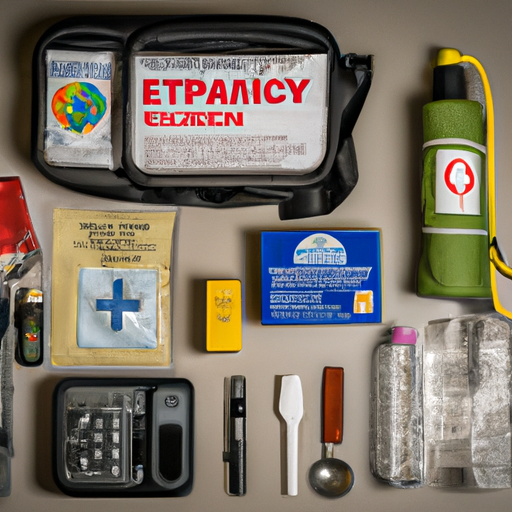As an Amazon Associate I earn from qualifying purchases.
Are you prepared for emergencies? From natural disasters to unexpected medical emergencies, it’s important to have a plan in place to ensure your safety and well-being. In this comprehensive guide, we will discuss everything you need to know about emergency preparedness and the steps you can take to be ready for any situation that may arise.
In the following paragraphs, we will delve into the different types of emergencies you may encounter and the specific preparations you can make to mitigate their impact on your life. Whether it’s creating a home emergency kit, developing an emergency communication plan, or learning basic first aid skills, we’ll cover all the bases to help you feel confident and prepared. So, if you want to be equipped with the knowledge and resources necessary to handle emergencies effectively, keep reading to discover more in our detailed article about emergency preparedness!

Preparing for Emergencies: A Comprehensive Guide
Emergencies can happen at any time and it’s important to be prepared. Whether it’s a natural disaster, such as a hurricane or earthquake, or a man-made event, like a fire or a terrorist attack, being ready for the unexpected can make all the difference. In this comprehensive guide, we will explore the types and causes of emergencies, the impact they can have, and the steps you can take to ensure you are prepared.
Understanding Emergencies
Emergencies come in various forms, and it’s essential to understand the different types in order to prepare effectively. Some common types of emergencies include natural disasters like floods, hurricanes, earthquakes, and tornadoes. Additionally, there are technological emergencies such as chemical spills, power outages, and infrastructure failures. Finally, there are man-made emergencies like fires, terrorist attacks, and civil unrest. Each type of emergency requires a unique approach to preparedness, so it’s important to be aware of the risks in your area.
Causes of Emergencies
Emergencies can be caused by a wide range of factors. Natural disasters are often caused by geological events, like seismic activity or extreme weather conditions. They can also result from human activities, such as deforestation or climate change. Technological emergencies may be caused by equipment failures, human error, or intentional acts. Man-made emergencies can arise from conflict, criminal activities, or accidents. By understanding the causes of emergencies, you can better anticipate and mitigate their effects.
Impact of Emergencies
Emergencies can have a significant impact on individuals, communities, and societies as a whole. They can cause injury or loss of life, damage to infrastructure and property, disruption of essential services, and a strain on emergency response systems. The psychological impact of emergencies can also be profound, causing stress, anxiety, and trauma. By recognizing the potential impact of emergencies, you can take steps to minimize their effects and protect yourself and your loved ones.
Assessing Your Risks
To effectively prepare for emergencies, it’s crucial to assess the risks in your area. This involves identifying potential hazards, evaluating vulnerability, and understanding the risks facing your community.
Identifying Potential Hazards
Start by identifying the potential hazards that could affect your area. Consider the geographical location, climate, and history of your region. Is it prone to earthquakes, floods, or wildfires? Are there any industrial sites or transportation routes nearby that could pose a risk? Understanding the specific hazards you may face will help you tailor your emergency preparedness efforts.
Evaluating Vulnerability
Next, evaluate your vulnerability to these hazards. Assess the specific characteristics of your home, such as its construction and location. Consider the accessibility of exits, the stability of structures, and the availability of emergency supplies. Evaluate your own physical abilities and any specific needs you or your family members may have. By understanding your vulnerability, you can take steps to mitigate risks and enhance your preparedness.
Understanding Community Risks
It’s essential to understand the risks that your entire community may face. Research local emergency plans, attend community meetings, and connect with local emergency management agencies. By staying informed and involved, you can contribute to the development of community-wide emergency plans and ensure that everyone is prepared for potential emergencies.
Creating an Emergency Plan
Once you have assessed the risks and vulnerabilities, it’s time to create an emergency plan. This plan should outline the steps you will take before, during, and after an emergency to ensure your safety and well-being.
Establishing a Communication Plan
A crucial part of any emergency plan is establishing a communication system. Identify a designated family member or friend who will serve as a central point of contact. Share contact information with each other and establish a backup communication method in case phone lines or internet services are disrupted. Designate a meeting place where you can reunite if separated during an emergency.
Designating Meeting Points
In addition to a central meeting place, it’s important to designate specific meeting points outside of your immediate area. These meeting points should be easily recognizable and accessible, and they can serve as gathering places if you are unable to return home or if your home is no longer safe.
Building a Shelter-in-Place Strategy
In some emergencies, it may be safer to stay indoors rather than evacuate. This is known as sheltering in place. Prepare a designated area in your home where you can seek shelter during emergencies, such as a basement or an interior room without windows. Stock this area with emergency supplies, including food, water, flashlights, and a battery-powered radio.
Building an Emergency Kit
Having an emergency kit ready can make a crucial difference in your preparedness. Here are some essential supplies and equipment to include in your emergency kit:
Essential Supplies and Equipment
- Non-perishable food that can last for several days, such as canned goods, energy bars, and dried fruits
- Drinking water, at least one gallon per person per day for a minimum of three days
- Flashlights with extra batteries
- First aid kit with essential medical supplies
- Multi-purpose tool
- Whistle to signal for help
- Dust masks and plastic sheeting for sheltering in place
- Sanitation and personal hygiene items
- Extra clothing and blankets
- Cash and important documents in waterproof containers
Medical Necessities
If you or your family members have specific medical needs, ensure that your emergency kit includes necessary medications, prescription glasses, spare batteries for medical devices, and any other essential medical supplies. Also, consider keeping copies of important medical records and contact information for healthcare providers in your emergency kit.
Food and Water Provisions
In addition to the non-perishable food and water included in your emergency kit, consider stocking extra supplies in your home. These provisions should be rotated regularly to ensure their freshness. Remember to include baby formula, diapers, and any special dietary items for family members with specific needs.

Emergency Evacuation
In some emergencies, evacuating your home may be necessary for your safety. Here are some important considerations when planning for emergency evacuations:
Evacuation Routes
Identify primary and alternative evacuation routes from your home or workplace. Familiarize yourself with these routes and map them out in advance. Be aware of any potential obstacles, such as closed roads or bridges, and have alternative routes planned.
Transportation Considerations
Consider how you will evacuate, especially if you don’t have access to a personal vehicle. Identify public transportation options, arrange transportation with relatives or friends, or locate designated evacuation centers in your area. Be sure to plan for any special transportation needs, such as wheelchair accessibility or accommodations for pets.
Pets and Livestock Evacuation
If you have pets or livestock, include them in your evacuation plan. Identify pet-friendly shelters, hotels, or boarding facilities in advance. Keep a supply of pet food, medication, and other necessities in your emergency kit. Also, consider registering your pets with local authorities, so they can be easily reunited with you in case of separation.
Emergency Contacts
Having a list of emergency contacts readily available can be invaluable during a crisis. Here are some essential contacts to include in your emergency plan:
Local Emergency Services
Research the contact information for your local emergency services, such as police, fire, and medical services. Save these numbers in your phone and keep a hard copy in your emergency kit. Familiarize yourself with the non-emergency numbers for these services, as well.
Contacting Family and Friends
Compile a list of contact information for your family members, friends, and neighbors. Include their phone numbers, email addresses, and social media profiles. Share this list with each other, so you can quickly reach out and check on each other’s well-being during an emergency.
Registering for Emergency Alerts
Sign up for local emergency alert systems through text messages, phone calls, or email notifications. Many municipalities and emergency management agencies offer these services, which can provide real-time information about emergencies in your area. Stay informed and be prepared to take action based on these alerts.
Emergency Preparedness for Specific Needs
It’s important to consider the specific needs of individuals with disabilities, children, and the elderly when preparing for emergencies.
Preparing for Individuals with Disabilities
If you or someone in your household has a disability, tailor your emergency plan to accommodate their specific needs. This may include having extra medical supplies, mobility devices, or communication aids readily available. Additionally, reach out to local disability organizations or agencies for guidance on emergency preparedness for individuals with disabilities.
Special Considerations for Children and the Elderly
Children and the elderly are particularly vulnerable during emergencies. Ensure that your emergency plan takes into account their unique needs and capabilities. Have extra supplies, clothing, and comfort items available for children. Make arrangements for any necessary child care or elderly care during an emergency. Communicate with schools, daycare centers, and nursing homes about their emergency procedures and ensure they have your emergency contact information.
Handling Pets and Service Animals
Pets and service animals are important members of our families. Plan ahead for their safety and well-being during emergencies. Have extra supplies, including food, water, medication, and bedding, readily available for them. Keep a leash, carrier, or harness near their emergency supplies. And don’t forget to pack their medical records and any needed identification tags.
Emergency Financial Planning
Emergencies can take a toll not only on your physical and emotional well-being but also on your finances. Here are some important considerations for emergency financial planning:
Insurance Coverage
Review your insurance policies to ensure they provide adequate coverage for potential emergencies, such as natural disasters or accidents. Consider additional insurance options, like flood insurance, if you live in a high-risk area. Understand your policy terms, deductibles, and claim procedures. Keep a copy of your insurance policies and contact information in your emergency kit.
Emergency Funds and Savings
Having an emergency fund can provide a financial safety net during a crisis. Aim to build a savings account that can cover at least three to six months’ worth of living expenses. Set aside money each month specifically for emergencies. Use budgeting techniques to manage your expenses and prioritize saving for emergencies.
Recovering After a Disaster
After an emergency, recovery can be a long and challenging process. Take steps to expedite your recovery by documenting any damage and filing insurance claims promptly. Keep all receipts for repairs and expenses related to the emergency. Reach out to local and federal disaster assistance programs for financial support. Be cautious of scams and unscrupulous contractors, and always verify the legitimacy of any assistance programs before providing personal or financial information.
Staying Informed
Staying informed is vital during emergencies. Here are some ways to ensure you have accurate and timely information:
Monitoring News and Weather Updates
Stay tuned to local news channels and radio stations for updates on potential emergencies. Many news outlets also provide alerts and notifications through mobile apps, so consider downloading reputable news apps for your smartphone. Follow verified social media accounts of local authorities for real-time information during emergencies.
Utilizing Mobile Apps and Emergency Radios
Emergency preparedness apps can provide valuable information and resources during a crisis. These apps often include features like emergency alerts, disaster planning tools, and access to local emergency services. Additionally, consider investing in a battery-powered or hand-cranked emergency radio. This can provide you with critical information, even if power and internet services are disrupted.
Official Government Sources for Information
As emergencies unfold, official government sources become key sources of accurate information. Familiarize yourself with the websites and social media accounts of your local emergency management agency, as well as state and national emergency response agencies. These sources will provide you with authoritative information and guidance during emergencies.
Conclusion
Preparing for emergencies is not a task to be taken lightly. By understanding the different types and causes of emergencies, assessing your risks, and creating an emergency plan, you can ensure your readiness in any situation. Building an emergency kit, knowing how to evacuate, and staying informed are all crucial steps in being prepared. Remember, preparation is key to safeguarding yourself and your loved ones. Take the necessary steps now, and you’ll be better equipped to handle any emergency that comes your way.
As an Amazon Associate I earn from qualifying purchases.










